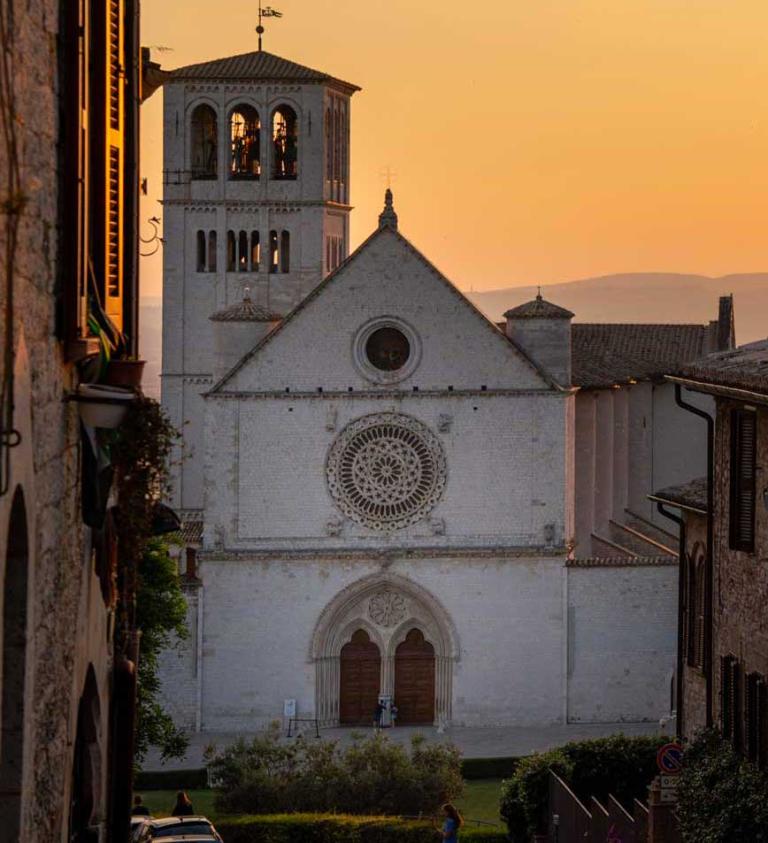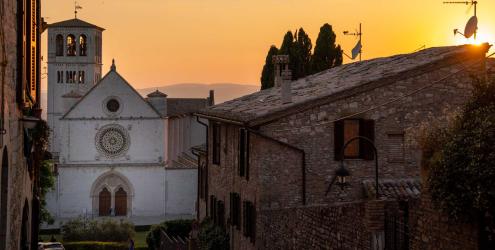



The Way of St. Francis (we’ve explained elsewhere how it differs from, and resembles, the Via Francigena) is inspired by the life of St. Francis, Italy’s patron saint — a figure who, beyond the religious dimension, fascinates for his deep love of nature, his energy and hospitality, his sense of connection and compassion.
St. Francis of Assisi is one of the most beloved figures of Christian spirituality. Yet beyond sainthood, he was a man who chose simplicity, poverty, and a direct relationship with nature and with others — so much so that centuries later he became a symbol of peace and the patron of ecology. His love for animals, his way of seeing creation not as backdrop but as companion, and his life’s moments embedded in wild places make him a figure whose legacy still speaks to many—religious or not.
The “Way of St. Francis” isn’t a single medieval road but a constellation of routes that connect the places of his life and message. Walking them today means following, step by step, his human and spiritual legacy — at your own pace, in your own way. It doesn’t require religious motives: many walkers choose it to connect with the energy of the landscapes, to reconnect with nature, to discover the “green heart of Italy,” and to welcome a gentler tempo of life.
Origins. Francis was born in Assisi around 1181/1182 as Giovanni di Pietro di Bernardone, the son of a prosperous cloth merchant. He grew up in comfort, attending festive city life and social celebration; the nickname “Francesco” is thought to reflect his father’s admiration for French culture.
Youth. He loved chivalric ideals and adventures. Serving as a soldier, he was captured in the war between Assisi and Perugia in 1202. Illness during his imprisonment became a turning point that led to deeper questioning of his privileged life.
Conversion. A series of experiences marked his transformation: embracing a leper, hearing the call to “repair my church,” and a growing sense that true freedom meant letting go. He renounced his wealth publicly before the bishop of Assisi, embraced radical simplicity, and began living itinerantly.
Religious communities. He founded the Friars Minor in 1209, inspired St. Clare to establish the Poor Clares, and created the Third Order for laypeople. His simple rule emphasized poverty, service, and walking as a way of life.

To walk in his spirit. These routes aren’t just about reaching holy sites; they invite you to live something central to Francis’ life: harmony with nature, humility, and deep presence. The landscapes he moved through—forests, hills, valleys, old villages—are still there, alive and accessible, and they pulse with the atmosphere Francis once breathed.
A transformative experience. Walking slows time. It allows your senses to open: morning light in olive groves, shadows in cedar forests, the scent of damp earth, the distant bell of a monastery. Meeting people in small inns, hearing stories in village squares, tasting regional foods—all these become part of your journey. With the logistics handled, there’s space to simply walk, think, not think, and let the journey reshape something inside you.
A living tradition. If the Via Francigena was the grand medieval route toward Rome, the Franciscan ways stitch together the actual movements of Francis and his companions. From La Verna to Assisi, through Umbria and Lazio, the route becomes a map of hope, of friendship, of nature. You are walking history, but also forging your own memories.
There was no singular path laid out in Francis’ time like today’s Camino to Santiago. But he traveled widely, and the routes we walk today connect those journeys:
Today’s itineraries translate these movements into coherent walking routes, connecting the key sanctuaries, hermitages, and villages into a network designed for modern travelers.
Assisi. The Basilica of St. Francis holds his tomb and Giotto’s frescoes of his life. The Porziuncola inside Santa Maria degli Angeli was the heart of his early community.
La Verna. A mountaintop sanctuary deep in Tuscan woodlands, filled with silence and raw natural beauty.
Greccio. A hillside village where Francis created the first nativity scene, expressing humility and humanity.
Rieti Valley. Known as the “Sacred Valley,” dotted with sanctuaries that hosted Francis for prayer, writing, and retreat.
Gubbio. Famous for the story of the wolf, tamed by Francis and remembered as a sign of reconciliation between people and the natural world.
Other highlights on the routes include Spoleto with its cathedral and fortress, Città di Castello with Renaissance treasures, Sansepolcro, and even Florence, which is often a starting point.

The Canticle of the Creatures. One of the earliest poems in Italian, where Francis addresses Brother Sun, Sister Moon, and the elements as kin.
Creatures and care. From the sermon to the birds to the wolf of Gubbio, Francis’ empathy toward all living beings feels strikingly modern.
Recognition and relevance. Declared Patron of Ecology in 1979, his legacy continues to inspire contemporary ideas of sustainability, simplicity, and balance with the natural world.
Routes, Stages & Distances
Daily Rhythm, Stage Difficulty & Terrain
Stages range from 12 km to 30+ km. Some are gentle, winding through rolling hills; others are more demanding, with steep ascents or longer distances. Expect forest paths, gravel roads, quiet countryside lanes, and stretches of medieval mule tracks.

Lodging varies from simple pilgrim hostels to charming agriturismi and small hotels. In smaller villages options can be limited, so booking in advance is recommended. Luggage transfer services are available to lighten the load, making the walk accessible for a wider range of travelers.
The Way of St. Francis is for anyone willing to embrace walking. Some fitness preparation is useful, as hills and distances can be demanding. But it’s not about racing: it’s about finding your rhythm, savoring each day, and letting the landscapes work their quiet magic.
Common starting points are La Verna, Assisi, or Rome. Assisi is easily reached by train, Rome by international flights, and smaller trailheads by regional transport or transfers.
Walking here also means immersing yourself in Tuscan and Umbrian traditions: fresh olive oil, local cheeses, truffles, seasonal produce, and wines. Medieval villages and Renaissance towns along the way are cultural treasures in themselves, offering history and hospitality in equal measure.
The Way of St. Francis is more than a path: it is a call to walk slowly, to open to others, to see nature as a gift, and to rediscover balance. It isn’t only about retracing the steps of a saint, but about reconnecting with yourself and the world around you.
Whether you walk a short section or the entire route, the Way of St. Francis offers what a journey should: time well spent, places that speak, and an experience that stays with you long after you return home.
`